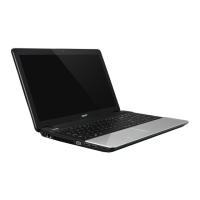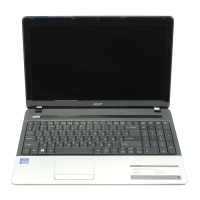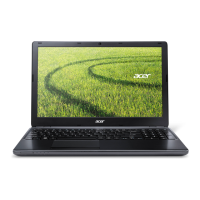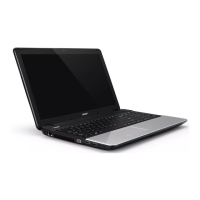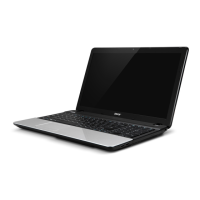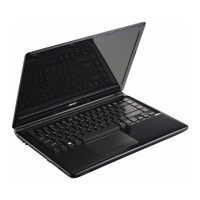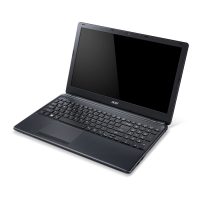Do you have a question about the Acer Aspire E1-572 and is the answer not in the manual?
Precautions for using electrical power, handling cords, and disconnecting sources.
Guidelines for safe battery usage, charging, handling, and replacement.
Warnings about RF interference, explosive environments, disposal, and emergency calls.
Tips for comfortable computer use, posture, vision care, and work habits.
Introduction to the available guides for new Acer notebook users.
Essential advice on computer maintenance, power management, and cleaning.
Identifies webcam, screen, and microphone on the laptop.
Details the power button, keyboard, and touchpad components.
Describes Kensington lock, VGA, Ethernet, and USB 3.0 information.
Details battery release, memory/HDD compartments, speakers, and cooling fan.
Explains the function of Caps Lock, Num Lock, and Scroll Lock keys.
Details special key combinations for controlling system functions.
Explains the functionality of the Windows and Application keys.
Covers fundamental touchpad operation and basic gestures like sliding and tapping.
Explains multi-finger gestures for navigation and control in Windows 8.
Steps to create a system backup for restoring the computer.
Process to back up factory-loaded software and drivers.
Procedures for restoring the system from Windows or a backup.
Instructions to turn off fast startup for reduced battery drain.
Information on battery recharge, charge-in-use, and charging procedures.
Tips to extend battery operation time and efficiency.
Checking battery level, low battery warnings, and installation/removal.
Steps for disconnecting accessories, preparing for transit, and moving locally.
Advice on what to bring, special considerations, and international travel.
Tips for setting up a comfortable and productive home office environment.
How to use a Kensington-compatible security slot and lock.
Setting up Supervisor and User passwords for system security.
How to connect the computer to an Ethernet-based network using a cable.
Connecting to the internet and understanding wireless LANs.
Explanation of the High-Definition Multimedia Interface for audio/video connections.
Information on the USB port as a high-speed serial bus for peripherals.
How to play DVDs and the regional code system.
How to set the boot sequence within the BIOS utility.
Procedure for setting boot passwords in the BIOS utility.
Solutions for power-on failures and blank screens.
Addressing issues with no audio output or unresponsive keyboards.
Common printer problems and how to request service.
General tips and a guide to interpreting and resolving error messages.
Accessing charms, Start, switching apps, and turning off the computer.
Customizing the computer, moving tiles, and managing app appearance.
Statement on FCC compliance, shielded cables, and peripheral device regulations.
Compliance with Canadian ICES-003 and EU directives, including wireless bands.
Information on RF field exposure limits and restrictions for wireless devices.
| Operating System | Windows 8 |
|---|---|
| Weight | 2.35 kg |
| Wireless | Wi-Fi 802.11b/g/n, Bluetooth 4.0 |
| RAM | 4GB DDR3L |
| Storage | 500GB HDD |
| Display | 15.6-inch, 1366 x 768 pixels |
| Graphics | Intel HD Graphics 4400 |
| Battery | 6-cell Li-ion battery |
| Ports | 1 x USB 3.0, 2 x USB 2.0, HDMI, VGA, Ethernet |
| Processor | Intel Core i5-4200U |


